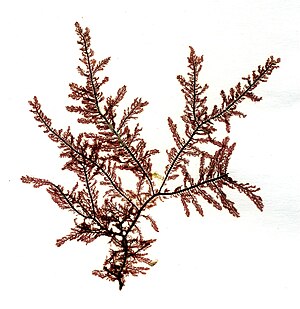Dainty sea feather
| Dainty sea feather | ||||||||||||
|---|---|---|---|---|---|---|---|---|---|---|---|---|

Dainty sea feather ( Plumaria plumosa ), |
||||||||||||
| Systematics | ||||||||||||
|
||||||||||||
| Scientific name of the genus | ||||||||||||
| Plumaria | ||||||||||||
| F. Schmitz | ||||||||||||
| Scientific name of the species | ||||||||||||
| Plumaria plumosa | ||||||||||||
| ( Hudson ) Kuntze |
The petite sea feather ( Plumaria plumosa , Syn . : Plumaria elegans ) is a type of red algae . It occurs on the stony coasts of the Northeast Atlantic , the North Sea and the Baltic Sea .
description
The delicate sea feather is attached to the ground with an adhesive disk. The soft thallus is bright red to blackish-dark red and is about 5–10 (rarely up to 12) cm high. It consists of a flattened main axis with a maximum width of 1 mm, which is repeatedly branched irregularly pinnate-like in one plane. The side branches are also somewhat flattened and densely covered with feathers. The thallus is barked, with the exception of the last-order leaflets. These are single-row, have paired side boxes on each axial cell and end with a blunt cell. The last side boxes are very close and curved, the branches on the outside are longer than the inner ones.
Development cycle
In January, the algae sprouts from overwintered thallus remains. During the summer, the main axes elongate and the color becomes darker. The reproductive structures arise at the ends of the leaflets. There occur both gametophyte (haploid), Tetrasporophyten (diploid) and triploid thalli on with parasporal.
Occurrence
The delicate sea feather is widespread on the coasts of the Northeast Atlantic from Scandinavia to Portugal . It was also found off North America. It occurs on the German coasts near Heligoland and in the western Baltic Sea .
It inhabits the middle and especially the lower intertidal zone . There it grows on rocks, under stocks of sawwrack ( Fucus serratus ) or on shady harbor walls. Occasionally it is also found sublittoral on stems of palm wrack ( Laminaria hyperborea ).
Systematics
The first scientific description was in 1762 by William Hudson under the name Fucus plumosus (in: Flora anglica , p. 473). Carl Ernst Otto Kuntze placed the species in the genus Plumaria in 1891 . It is the only species of this genus that is still accepted today.
Synonyms are Ceramium plumosum (Hudson) Roth , Fucus plumosus Hudson , Plumaria elegans (Bonnemaison) F.Schmitz , Plumaria plumosa var. Tenuissima C.Agardh , Ptilota elegans Bonnemaison , Ptilota sericea Harvey and Ptilota plumosa var. Tenuissima C.Agardh .
Individual evidence
- ↑ a b c d Wolfram Braune: Marine algae. A color guide to the common benthic green, brown and red algae of the world's oceans . Ruggell: Gantner, 2008, ISBN 978-3-906166-69-8 , pp. 466-467.
- ↑ a b Michael Guiry: The Seaweed Site: information on marine algae: Plumaria plumosa , accessed on November 9, 2015.
- ↑ a b c P. Kornmann, PH Sahling: Sea algae from Helgoland - Benthic green, brown and red algae. Biological Institute Helgoland, Hamburg 1983, ISSN 0017-9957 , pp. 234-235.
- ↑ a b c d Michael D. Guiry in Michael D. Guiry, GM Guiry: Plumaria plumosa - In: Algaebase - World-wide electronic publication, National University of Ireland, Galway, accessed September 18, 2017.
- ↑ Dirk Schories, Uwe Selig, Hendrik Schubert: Species and synonym list of the German marine macroalgae based on historical and recent records (list of species and synomes of macroalgae in German coastal waters - evaluation of historical and recent findings) . In: Rostock. Marine biologist Contribution , Issue 21, 2009, p. 77. PDF file